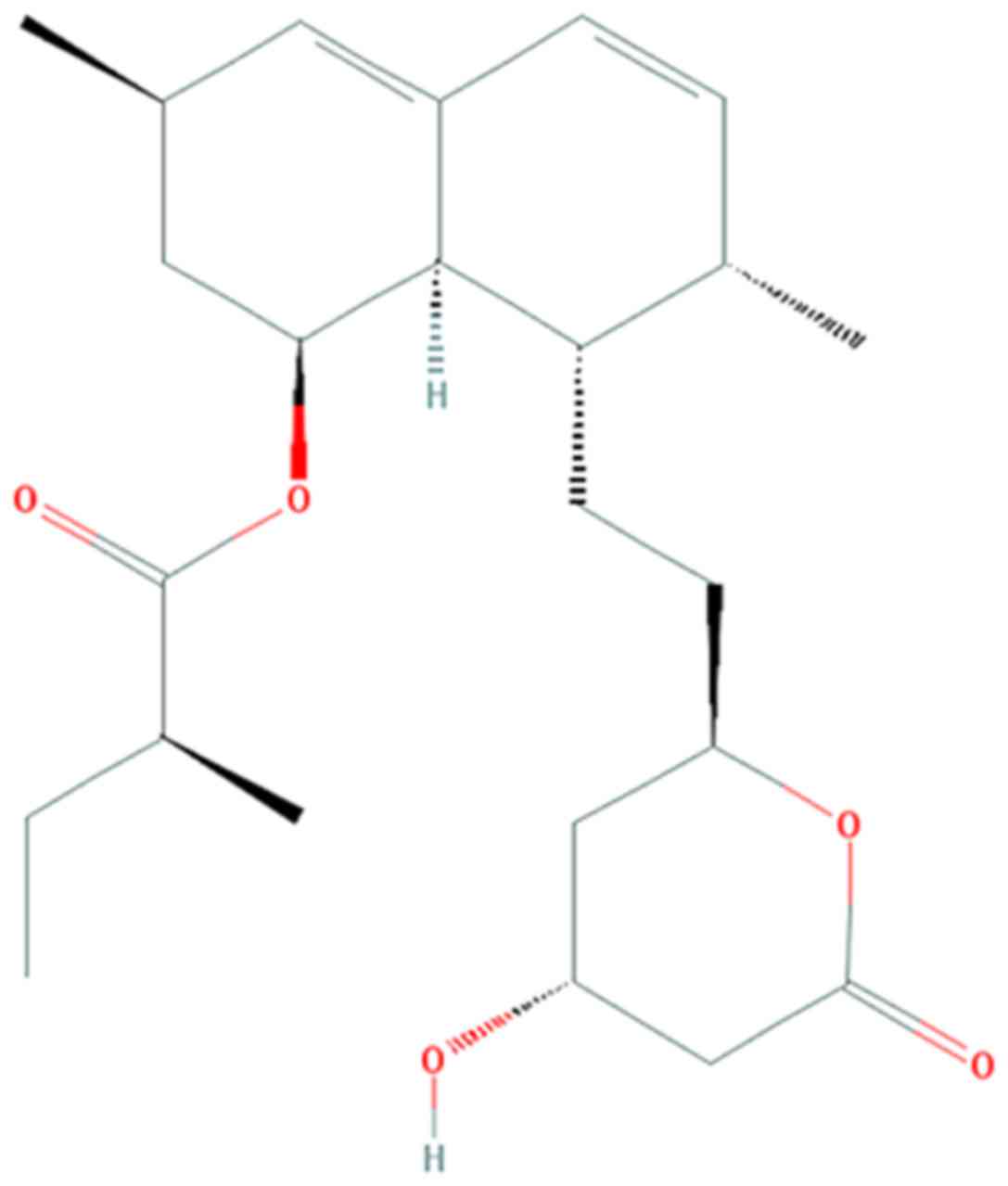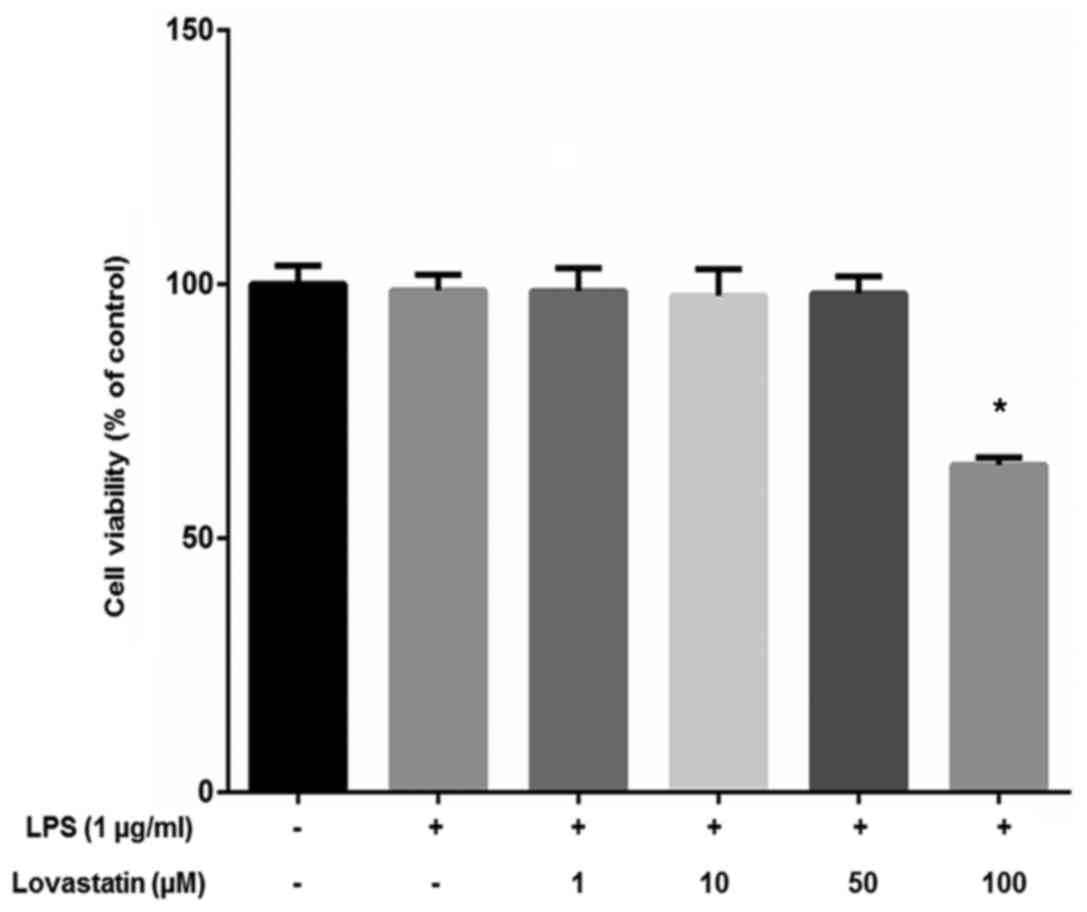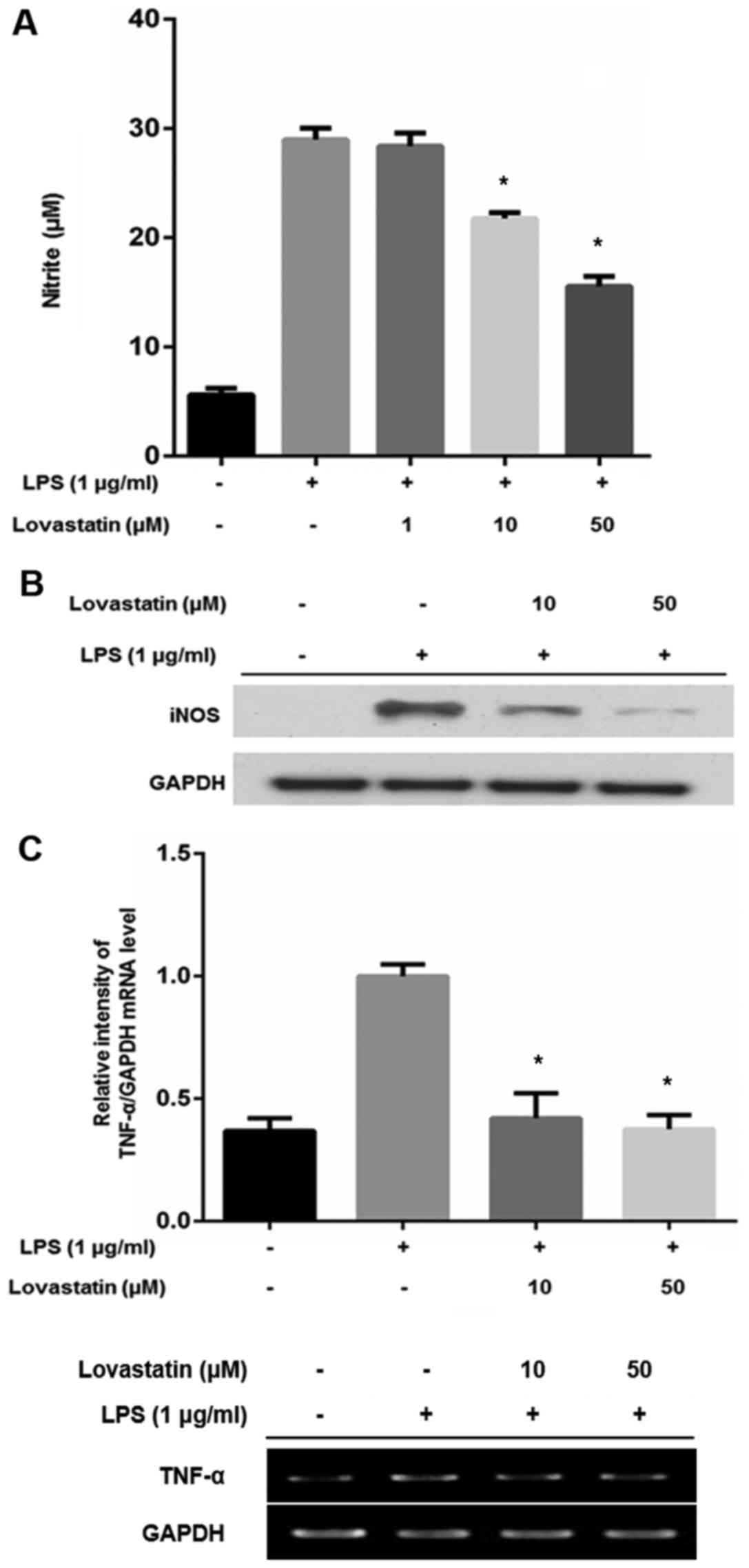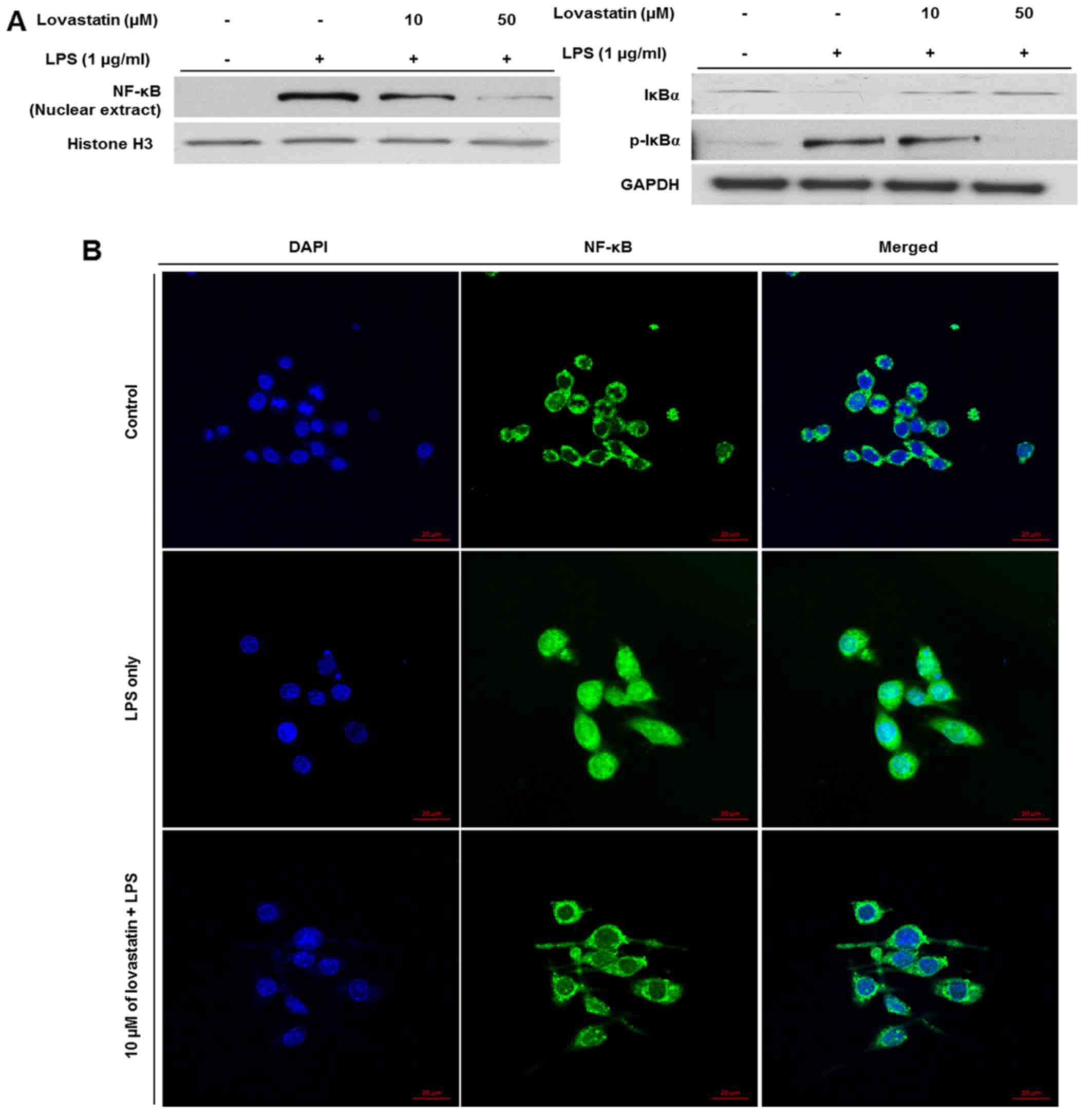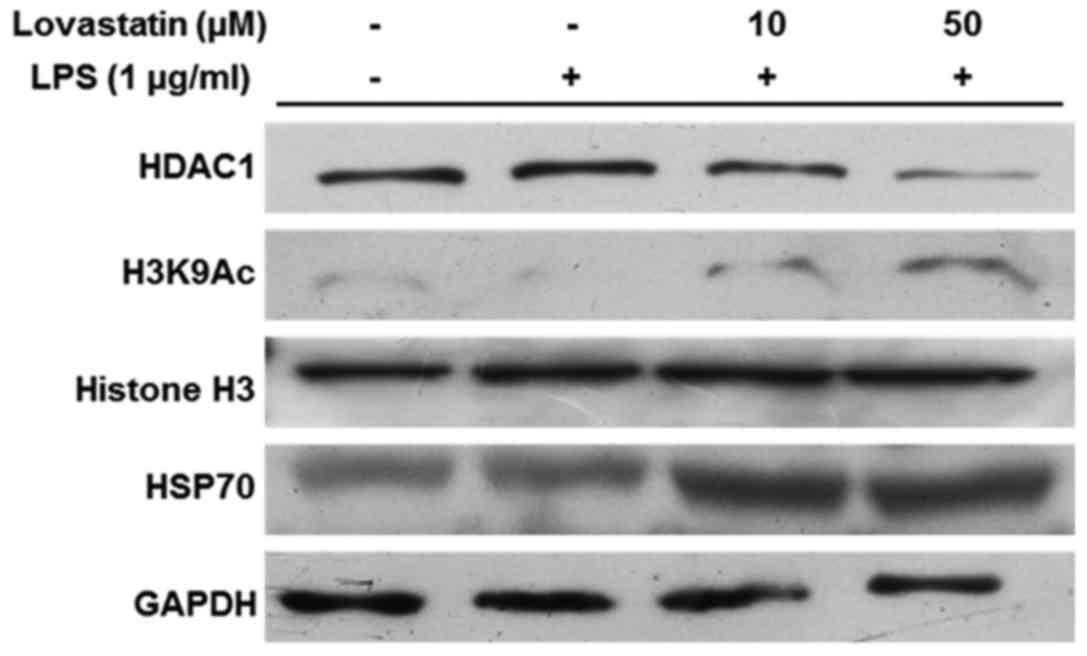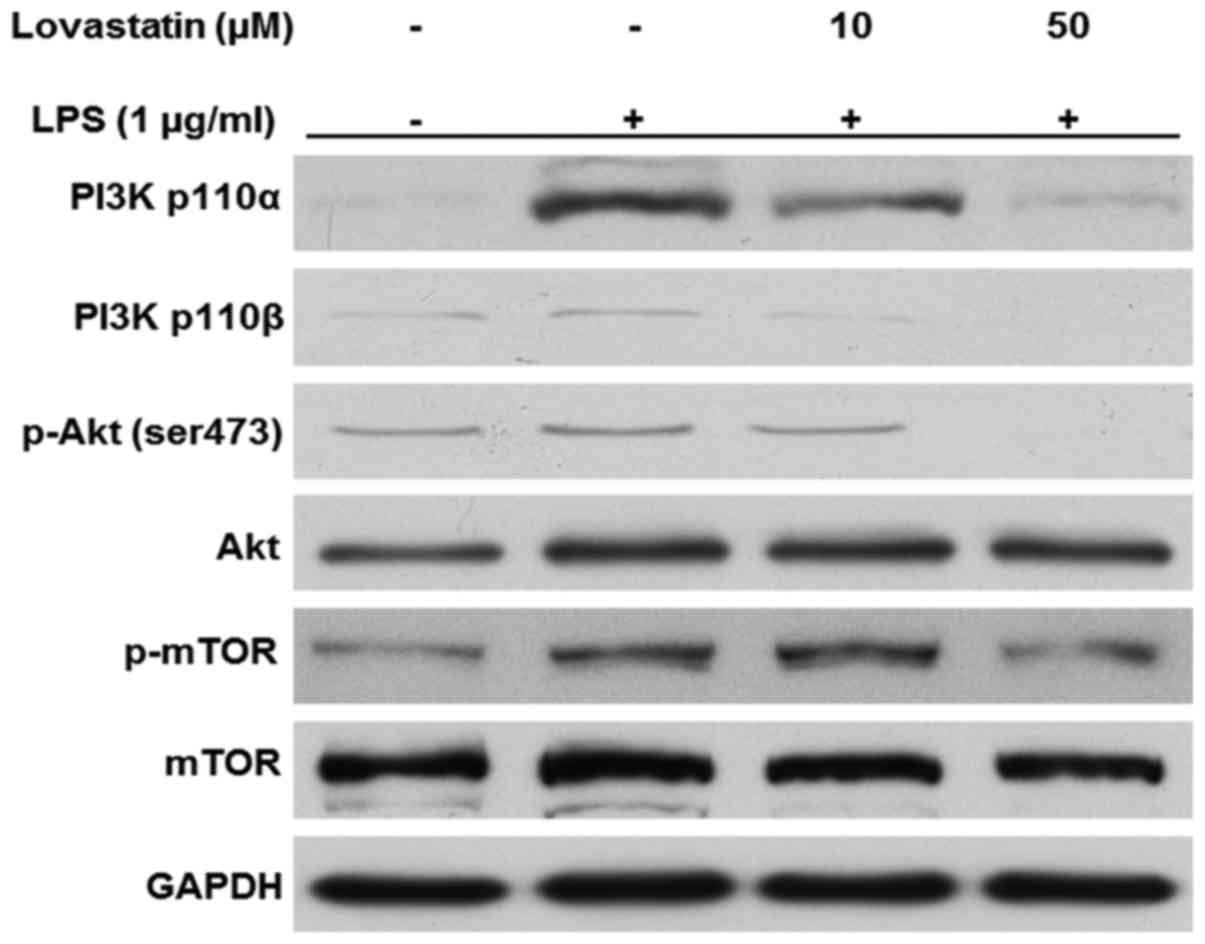Anti-inflammatory effect of lovastatin is mediated via the modulation of NF-κB and inhibition of HDAC1 and the PI3K/Akt/mTOR pathway in RAW264.7 macrophages
- Authors:
- Published online on: December 5, 2017 https://doi.org/10.3892/ijmm.2017.3309
- Pages: 1103-1109
Abstract
Introduction
Inflammation is a defense response against infection, tissue injury or noxious stimuli. In the inflammatory process, inflammatory products such as nitric oxide (NO) and pro-inflammatory cytokines serve important roles (1). In particular, NO is a crucial mediator for the amplification of the inflammatory response. NO is generated from L-arginine by inducible nitric oxide synthase (iNOS). NO has various biological functions in mammalian cells, including microbial immunity, vasodilation and the modulation of cell signaling (2). However, the excessive production of NO may cause damage to normal tissues and exacerbate inflammatory diseases (3). The expression of iNOS and other inflammatory cytokines, such as tumor necrosis factor-α (TNF-α), is regulated by several transcription factors, one of which is nuclear factor-κB (NF-κB) (4). Therefore, the regulation of NO production in an excessive inflammatory response may facilitate the improvement of the inflammatory symptoms.
Previous studies have shown that NF-κB is regulated by several mechanisms, including histone acetylation and the phosphoinositide 3-kinase (PI3K)/protein kinase B (Akt)/mammalian target of rapamycin (mTOR) signaling pathway (5,6). The former mechanism, histone acetylation, is a post-transcriptional modification process that is involved in the regulation of gene transcription. This process is highly reversible and widespread in eukaryotes. Lysine residues in histones are a target of histone acetylation. Histone acetyltransferases and histone deacetylases (HDACs) are enzymes that regulate histone acetylation and deacetylation, respectively (7). One of the proteins that is regulated by histone acetylation and deacetylation is heat shock protein 70 (HSP70) (8). It has been revealed that the accumulation of HSP70 in the cytoplasm prevents the translocation of cytosolic NF-κB into the nucleus (8). In the latter mechanism of NF-κB regulation, PI3K/Akt/mTOR signal transduction. PI3K catalyzes the phosphorylation of phosphatidylinositol (4,5)-bisphosphate to phosphatidylinositol (3,4,5)-trisphosphate, which then phosphorylates Akt. The phosphorylated Akt mediates the phosphorylation of mTOR, and the phosphorylated mTOR encourages the translocation of NF-κB into the nucleus (9,10).
Lovastatin is an inhibitor of 3-hydroxy-3-methylglutaryl-CoA (HMG-CoA) used clinically for the prevention of cardiovascular diseases via the lowering of cholesterol levels. Commercially, lovastatin is obtained by the fermentation of Aspergillus terreus, but several edible mushrooms, such as Pleurotus ostreatus, are reported to produce high quantities of lovastatin (11). Studies have demonstrated that lovastatin also has anticancer and anti-inflammatory effects in vitro and in vivo (12,13). The chemical structure of lovastatin is presented in Fig. 1 (12).
The precise mechanisms associated with the anti-inflammatory effects of lovastatin have not been fully elucidated. Therefore, in the present study, the anti-inflammatory effects of lovastatin were investigated and its molecular mechanism was explored, focusing on HDAC1, HSP70 and the PI3K/Akt/mTOR signaling pathway in lipopolysaccharide (LPS)-stimulated RAW264.7 macrophage cells. The results should indicate whether lovastatin has potential as an inflammatory suppressor, and may support the further clinical application of lovastatin.
Materials and methods
Cell culture and reagents
RAW264.7 murine macrophage cells were purchased from the American Type Culture Collection (Manassas, VA, USA). The cells were cultured in Dulbecco's modified Eagle's medium (DMEM) supplemented with 10% fetal bovine serum (FBS) and 1% (v/v) penicillin (100 U/ml)/streptomycin (100 µg/ml). The cells were incubated under humidified conditions with 5% CO2 at 37°C. Lovastatin (Mevinolin), Escherichia coli LPS and Griess reagent were purchased from Sigma-Aldrich (Merck KGaA, Darmstadt, Germany). The DMEM, FBS and penicillin/streptomycin were purchased from Mediatech (Corning Life Sciences; Manassas, VA, USA). Monoclonal antibodies targeting iNOS (13120S), glyceraldehyde 3-phosphate dehydrogenase (GAPDH; 5174S), NF-κB (8242S), inhibitor of NF-κBα (IκBα; 4814S), phosphor (p)-IκBα (ser32; 2859S), HDAC1 (5356S), acetyl-histone H3 (lys9; 9649S), histone H3 (9717S), PI3K p110α (4249S), PI3K p110β (3011S), Akt (4691S), p-Akt (ser473; 4060S), mTOR (2983S), p-mTOR (ser2481; 2974S) and HSP70 (46477S) were purchased from Cell Signaling Technology, Inc. (Danvers, MA, USA). Anti-rabbit IgG (H+L), F(ab′)2 fragment (Alexa Fluor® 488 conjugate; 4412S) was purchased from Invitrogen (Thermo Fisher Scientific, Inc., Waltham, MA, USA).
Cell viability assay
For the cell viability assay, the cells (1×104 cells/well) were seeded in 96-well microplates and then treated with 1, 10, 50 or 100 µM lovastatin for 24 h. The cells were then treated with 1 µg/ml LPS. The medium in each well was then discarded, and 100 µl DMEM containing 10% FBS was added to each well followed by 10 µl. EZ-cytox Cell Viability Assay Solution WST-1® (Daeil Lab Service, Gyenggi, Korea) and the cells were incubated for 3 h. Following this, the optical density was measured at 460 nm using a microplate reader (Molecular Devices, LLC, Sunnyvale, CA, USA).
Measurement of NO production
The cells were seeded in 24-well plates at a density of 5×104 cells/well. The cells were pretreated with a various concentration of lovastatin (1, 10 and 50 µM) for 1 h and then stimulated with LPS (1 µg/ml) for a further 24 h. To measure the NO production, 100 µl culture supernatant and the same volume of Griess reagent were reacted in a 96-well plate for 10 min at room temperature in the dark, and the absorbance was then measured at 540 nm using a microplate reader.
Western blot analysis
RAW264.7 cells were treated with LPS only or following pretreatment with lovastatin as described above prior to the western blotting of cell lysates. The cells were extracted using cell lysis buffer [(50 mM Tris-Cl (pH 7.5), 150 mM NaCl, 1 mM dithiothreitol, 0.5% NP-40, 1% Triton X-100, 1% deoxycholate and 0.1% sodium dodecyl sulfate (SDS)] and a cocktail of proteinase inhibitors (phenylmethane sulfonyl fluoride, EDTA, aprotinin, leupeptin and prostatin A; Intron Biotechnology, Inc., Seongnam, Korea). For the preparation of nuclear extracts, the cultured cells were harvested and lysed using NE-PER® Nuclear and Cytoplasmic Extraction reagents (Thermo Fisher Scientific, Inc.) according to the manufacturer's protocol. The protein concentration in the cell lysates was measured using Bradford reagent (Biosesang, Inc., Seongnam, Korea). Equal volumes of the prepared proteins (30 µg per lane) were resolved by 12% SDS-polyacrylamide gel electrophoresis and then transferred to a nitrocellulose membrane (Pall Life Sciences, Port Washington, NY, USA). The membrane was blocked with phosphate-buffered saline (PBS) with Tween-20 buffer (135 mM NaCl, 2.4 mM KCl, 4.3 mM NaPO4, 1.4 mM KH2PO4, and 0.5% Tween-20) containing 5% skimmed milk for 1 h and then incubated with primary antibodies [iNOS, GAPDH, NF-κB, IκBα, p-IκBα (ser32), Histone H3, HDAC1, acetyl-histone H3 (lys9), PI3K p110α, PI3K p110β, Akt, p-Akt (ser473), mTOR, p-mTOR (ser2481), and HSP70; dilution, 1:1,000; temperature, 4°C; duration, overnight]. Following the incubation, the membrane was incubated with anti-rabbit, anti-mouse or anti-rat IgG antibodies conjugated with horseradish peroxidase (dilution, 1:1,000; Cell Signaling Technology, Inc.) for 1 h at room temperature. The labeled proteins were detected by reaction with an enhanced chemiluminescent (ECL®) detection solution (Pierce; Thermo Fisher Scientific, Inc.).
Reverse transcription polymerase chain reaction (RT-PCR)
Total RNA was extracted from RAW264.7 cells using 2-mercaptoethanol (Sigma-Aldrich; Merck KGaA) and isolated using RNeasy plus mini kit (Qiagen, Venlo, Netherlands). A nanodrop (MECASYS, Daejeon, Korea) was used for quantifying the concentrations of total RNA. RNA (1 µg) was synthesized to cDNA with cDNA kit (Genetbio, Daejeon, Korea) and cDNA synthesis was performed at 42°C for 1 h and then at 94°C for 5 min. Genes encoded in 1 µg cDNA were amplified by PCR using specific primers as follows: TNF-α forward, 5′-CCC CTC AGC AAA CCA CCA AGT-3′ and reverse, 5′-CTT GGG CAG ATT GAC CTC AGC-3′; GAPDH forward, 5′-AAC TTT GGC ATT GTG GAA GG-3′ and reverse, 5′-CAC ATT GGG GGT AGG AAC AC-3′. PCR was performed under the following conditions: denaturation (92°C, 1 min), annealing (57°C, 30 sec), extension (72°C, 30 sec), and 23 cycles. Amplified PCR products were observed on 2% agarose gel with ethidium bromide. The intensity of bands was measured by Image J software (version 1.48; National Institutes of Health, Bethesda, MD, USA).
Immunofluorescence staining and confocal microscopy of NF-κB
RAW264.7 cells were seeded on coverglass-bottom dishes (SPL Life Sciences, Pocheon, Korea) and pretreated with 10 µM lovastatin for 1 h. The cells were then stimulated by incubation with LPS (1 µg/ml) for 24 h. Following incubation, the cells were stained using 1 µg/ml 4′,6-diamidino-2-phenylindole (DAPI; Roche Diagnostics GmbH, Mannheim, Germany) for 15 min at 37°C, washed with PBS and fixed with 4% formaldehyde (Junsei Chemical Co., Ltd., Tokyo, Japan) for 15 min at room temperature in the dark. The cells were blocked with blocking solution (5% normal rabbit serum and 0.3% Triton X-100) for 1 h in the dark at room temperature. The normal rabbit serum was purchased from Santa Cruz Biotechnology, Inc. (Dallas, TX, USA) and Triton X-100 was purchased from Sigma-Aldrich (Merck KGaA). The cells were incubated with the anti-NF-κB primary antibody (dilution, 1:2,000; Cell Signaling Technology, Inc.) at 4°C overnight. Following the reaction, the cells were washed with PBS and then treated with anti-rabbit IgG (H+L), F(ab′)2 fragment (Alexa Fluor® 488 conjugate; dilution, 1:2,000;) for 1 h at room temperature. The cells were washed with PBS and Prolong Gold Anti-fade Reagent® (Invitrogen; Thermo Fisher Scientific, Inc.) was added to the slide at room temperature. The cells were observed using a Carl Zeiss LSM 710 confocal laser scanning microscope (Zeiss GmbH, Jena, Germany).
Statistical analysis
To determine the statistical significance of the data, GraphPad Prism 6.0 (GraphPad Software, Inc., La Jolla, CA, USA) was used. The results are expressed as the mean ± standard deviation. Every experiment was performed in triplicate. One-way analysis of variance with post hoc Dunnett's multiple comparison tests were used to assess differences among the untreated, LPS only and lovastatin-treated groups. P<0.05 was considered to indicate a statistically significant difference.
Results
Viability of RAW264.7 cells following lovastatin treatment
The viability of the RAW264.7 macrophage cells was measured using the WST-1® assay. The cells were treated with 1, 10, 50 or 100 µM lovastatin with 1 µg/ml LPS. Lovastatin exhibited no significant effect on cell viability at concentrations ≤50 µM, but 100 µM lovastatin significantly inhibited the viability of the cells (Fig. 2). On the basis of the results of the cell viability assay, ≤50 µM lovastatin was used in further experiments to exclude the cytotoxic effects of lovastatin on RAW264.7 cells.
Lovastatin decreases NO production, iNOS and TNF-α expression in RAW264.7 cells
NO production was determined using Griess reagent in RAW264.7 cells treated with LPS alone, or LPS and lovastatin. When cells were treated with LPS only, the level of NO production was increased. However, when the RAW264.7 cells were also treated with 10 or 50 µM lovastatin, NO production was significantly decreased compared with that of the LPS-only treated cells (Fig. 3A). Since NO production was downregulated by 10 and 50 µM lovastatin but not 10 µM, it was postulated that 10 and 50 µM lovastatin may alter iNOS expression. Western blotting revealed that lovastatin decreased the expression of iNOS in an apparently dose-dependent manner, compared with that in the cells treated with LPS only (Fig. 3B). The mRNA level of TNF-α was also compared between the RAW264.7 cells treated with LPS alone and those treated with LPS in combination with lovastatin. The LPS treatment of RAW264.7 cells increased the TNF-α transcript ~2.5-fold. However, 10 and 50 µM lovastatin treatment significantly suppressed TNF-α expression at the transcriptional level (Fig. 3C). These results indicate that lovastatin has an inhibitory effect on the production of NO and the expression of iNOS and TNF-α in LPS-stimulated RAW264.7 cells.
Lovastatin prevents the nuclear translocation of NF-κB in LPS-stimulated RAW264.7 cells
As the aforementioned results show that iNOS and TNF-α expression were reduced at the protein and mRNA levels, respectively, it was hypothesized that lovastatin may affect the activation of transcription factors. Among various transcription factors, NF-κB is well-studied for its broad participation in the transcription of inflammatory mediators, including iNOS and TNF-α (14). To verify the regulatory effect of lovastatin on NF-κB activation, the nuclear expression of NF-κB was evaluated. The expression of NF-κB in nuclear extracts from the LPS-stimulated RAW264.7 cells was decreased by lovastatin, and the reduction appeared to be dose-dependent. Also, the expression of IκBα, which inhibits the nuclear translocation of NF-κB (15), was increased while the phosphorylation of IκBα was decreased, and the reduction in phosphorylation appeared to be a dose-dependent (Fig. 4A). When the cells were subjected to immunofluorescence staining (Fig. 4B), the expression of NF-κB (green) was detected in the nucleus (blue) as well as the cytosol of cells when the cells were treated with LPS only. However, when the RAW264.7 cells were treated with LPS plus 10 µM lovastatin, the expression levels of nuclear NF-κB (green) were decreased. The results demonstrate that lovastatin hinders LPS-induced NF-κB translocation from the cytosol into the nucleus, indicating that lovastatin may thereby suppress the inflammatory mediators, including iNOS and TNF-α, transcribed by NF-κB.
Lovastatin induces HSP70 accumulation via HDAC1 inhibition
Previous studies have indicated that HDAC1 mediates the exposure of the HSP70 promoter region through the acetylation of histone H3, and that HSP70 upregulation is able to block NF-κB translocation (16,17). In the present study, HDAC1 expression was markedly decreased by lovastatin, and the reduction appeared to be dose-dependent (10 and 50 µM). However, lovastatin treatment increased the acetylation of histone H3 at lysine 9. The expression and accumulation of HSP70 was increased when the RAW264.7 cells were treated with LPS in combination with 10 or 50 µM lovastatin (Fig. 5). Therefore, these results indicate that lovastatin regulates the expression of HSP70 by inducing the downregulation of HDAC1, which leads to the increased acetylation of histone H3 at the lysine 9 residue.
Lovastatin inhibits the PI3K/Akt/mTOR signaling pathway
In the present study, the PI3K/Akt/mTOR signaling pathway in LPS-stimulated macrophages appeared to be inhibited by the presence of lovastatin. The protein levels of the PI3K 110α and p110β catalytic subunits were increased when the cells were treated with LPS only; however, when the cells were treated with 10 or 50 µM lovastatin prior to LPS, the expression of the two PI3K subunits was decreased. Likewise, the phosphorylation of Akt at serine 473 residue and mTOR at serine 2481 residue were decreased by lovastatin in a comparable manner. However, lovastatin did not alter the expression of Akt and mTOR in the whole-cell lysates (Fig. 6). Therefore, these results suggest that lovastatin exerts regulatory effects on the PI3K/Akt/mTOR signaling pathway in LPS-stimulated RAW264.7 cells.
Discussion
Inflammation is an important innate immune response that protects the host from antigens. However, the overexpression of pro-inflammatory mediators, such as NO and pro-inflammatory cytokines, may occur as an aberrant inflammatory response (18,19). Macrophages serve pivotal roles in inflammation through the production of pro-inflammatory mediators and the regulation of inflammatory cells (18,20).
Lovastatin has been prescribed as a drug for the treatment of cardiovascular diseases for many years, and it has also been reported that lovastatin is able to inhibit tumor growth and inflammation (11,13,21). Previous studies have demonstrated that the inhibition of HDAC affects inflammation via various signaling pathways (22,23). In addition, many studies have revealed that the PI3K/Akt signaling pathway is associated with the inflammatory response. PI3K/Akt signal transduction acts upstream of NF-κB activation (24-26). Specifically, the inhibition of PI3K p110α and p110β subunits is reported to have a therapeutic function in the treatment of chronic inflammatory diseases (27). Therefore, in the present study, whether lovastatin reduces inflammation by the downregulation of HDAC and PI3K/Akt in LPS-stimulated RAW264.7 macrophage cells was investigated.
NO serves a key role in inflammation and it is used for the evaluation of macrophage activation (28). In the present study, lovastatin at the concentrations 10 and 50 µM decreased NO production without cytotoxicity in LPS-stimulated RAW264.7 cells. This result is consistent with the downregulation of iNOS expression that was also observed in response to lovastatin treatment in the present study, since iNOS promotes the production of NO (29). Another well-known target of anti-inflammatory treatment is TNF-α (30), the expression of which was decreased at the transcriptional level by lovastatin in the present study. Therefore, these data suggest that lovastatin regulates inflammation by decreasing NO production and TNF-α expression.
NF-κB is associated with the transcription of numerous pro-inflammatory factors, including iNOS and TNF-α (31). When activated, NF-κB is phosphorylated and translocated into the nucleus (32). However, the present study demonstrated through western blot analysis and immunofluorescence staining that the translocation of NF-κB was attenuated by lovastatin in LPS-stimulated RAW264.7 cells. Previously, studies have shown that NF-κB participates in the expression of iNOS and TNF-α (33-35). IκBα binds to NF-κB and suppresses its translocation; when IκBα is phosphorylated and degraded by proteasomes, NF-κB is activated and translocates into the nucleus (36). The western blotting results in the present study indicate that the expression of IκBα was increased and its phosphorylation was decreased in the presence of lovastatin. Thus, the lovastatin-induced reduction of iNOS and TNF-α expression may result from the inhibition of NF-κB translocation into the nucleus.
NF-κB activation is also regulated by HDAC1 expression. When HDAC1 expression is decreased, histone H3 acetylation at the lysine 9 residue is facilitated. The promoter region of the HSP70 gene is then exposed, which promotes HSP70 transcription (8). The accumulation of HSP70 in the cytoplasm leads to inhibition of the translocation of NF-κB from the cytoplasm into the nucleus (17). On the basis of previous studies, it was hypothesized that reduction of NF-κB translocation into the nucleus is associated with decreased HDAC1 expression and increased HSP70 expression. The western blotting results in the present study reveal that HDAC1 expression was downregulated by lovastatin in LPS-stimulated RAW264.7 cells. Also, histone H3 acetylation at lysine 9 and HSP70 expression was upregulated by lovastatin (10 and 50 µM) in the LPS-stimulated RAW264.7 cells. These results support the hypothesis that the inhibitory effect of lovastatin on HDAC1 disturbs the translocation of cytosolic NF-κB into the nucleus in LPS-stimulated RAW264.7 macrophages.
Although lovastatin may reduce NF-κB nuclear translocation via the induction of HSP70, the possibility that lovastatin influences other signal transduction pathways to regulate NF-κB activation in the cytoplasm was also considered. It has been reported that PI3K/Akt/mTOR signal transduction contributes to NF-κB translocation in the inflammatory response; PI3K phosphorylates Akt at serine 473, which induces NF-κB translocation (9). This regulatory function of the PI3K/Akt signaling pathway on NF-κB translation occurs through the phosphorylation of mTOR, downstream of Akt, at the serine 2481 residue (37). In the present study, western blotting revealed that the expression of PI3K p110α and p110β catalytic subunits in LPS-stimulated RAW264.7 cells was decreased by 10 and 50 µM lovastatin. In addition, the phosphorylation of PI3K and Akt was downregulated by lovastatin, resulting in reduced levels of mTOR expression in the LPS-stimulated RAW264.7 cells. This is likely to prevent the translocation of cytosolic NF-κB into the nucleus in the LPS-stimulated RAW264.7 cells.
In conclusion, the results of the present study indicate that the downregulation of HDAC1 expression and inhibition of the PI3K/Akt/mTOR signaling pathway by lovastatin results in the inhibition of cytosolic NF-κB translocation into the nucleus in LPS-stimulated RAW264.7 macrophages. Furthermore, the inhibitory effect of lovastatin on NF-κB activation induces an anti-inflammatory response in LPS-stimulated RAW264.7 macrophage cells through suppression of the expression of iNOS and TNF-α. These observations suggest that lovastatin is a potential therapeutic agent for the amelioration of inflammatory diseases via the regulation of macrophages.
Acknowledgments
The present study was supported by the Golden Seed Project (Center for Horticultural Seed Development; grant no. 213003-04-2-SBI10), Ministry of Agriculture, Food and Rural Affairs (MAFRA), Ministry of Oceans and Fisheries (MOF), Rural Development Administration (RDA) and Korea Forest Service (KFS).
References
|
Umamaheswari S and Sangeetha KS: Anti-Inflammatory Effect of Selected Dihydroxyflavones. J Clin Diagn Res. 9:FF05–FF07. 2015.PubMed/NCBI | |
|
Paradise WA, Vesper BJ, Goel A, Waltonen JD, Altman KW, Haines GK and Radosevich JA: Nitric oxide: Perspectives and emerging studies of a well known cytotoxin. Int J Mol Sci. 11:2715–2745. 2010. View Article : Google Scholar : PubMed/NCBI | |
|
Peng XX, Zhang SH, Wang XL, Ye TJ, Li H, Yan XF, Wei L, Wu ZP, Hu J, Zou CP, et al: Panax Notoginseng flower saponins (PNFS) inhibit LPS-stimulated NO overproduction and iNOS gene overexpression via the suppression of TLR4-mediated MAPK/NF-kappa B signaling pathways in RAW264.7 macrophages. Chin Med. 10:152015. View Article : Google Scholar : PubMed/NCBI | |
|
Medicherla K, Sahu BD, Kuncha M, Kumar JM, Sudhakar G and Sistla R: Oral administration of geraniol ameliorates acute experimental murine colitis by inhibiting pro-inflammatory cytokines and NF-κB signaling. Food Funct. 6:2984–2995. 2015. View Article : Google Scholar : PubMed/NCBI | |
|
Salminen A, Paimela T, Suuronen T and Kaarniranta K: Innate immunity meets with cellular stress at the IKK complex: Regulation of the IKK complex by HSP70 and HSP90. Immunol Lett. 117:9–15. 2008. View Article : Google Scholar : PubMed/NCBI | |
|
Hao NB, Tang B, Wang GZ, Xie R, Hu CJ, Wang SM, Wu YY, Liu E, Xie X and Yang SM: Hepatocyte growth factor (HGF) upregulates heparanase expression via the PI3K/Akt/NF-κB signaling pathway for gastric cancer metastasis. Cancer Lett. 361:57–66. 2015. View Article : Google Scholar : PubMed/NCBI | |
|
Ito K, Charron CE and Adcock IM: Impact of protein acetylation in inflammatory lung diseases. Pharmacol Ther. 116:249–265. 2007. View Article : Google Scholar : PubMed/NCBI | |
|
Marinova Z, Ren M, Wendland JR, Leng Y, Liang MH, Yasuda S, Leeds P and Chuang DM: Valproic acid induces functional heat-shock protein 70 via Class I histone deacetylase inhibition in cortical neurons: A potential role of Sp1 acetylation. J Neurochem. 111:976–987. 2009. View Article : Google Scholar : PubMed/NCBI | |
|
Zhao Y, Zhang C, Huang Y, Yu Y, Li R, Li M, Liu N, Liu P and Qiao J: Up-regulated expression of WNT5a increases inflammation and oxidative stress via PI3K/AKT/NF-κB signaling in the granulosa cells of PCOS patients. J Clin Endocrinol Metab. 100:201–211. 2015. View Article : Google Scholar | |
|
Pan H, Xu LH, Ouyang DY, Wang Y, Zha QB, Hou XF and He XH: The second-generation mTOR kinase inhibitor INK128 exhibits anti-inflammatory activity in lipopolysaccharide-activated RAW264.7 cells. Inflammation. 37:756–765. 2014. View Article : Google Scholar : PubMed/NCBI | |
|
Alarcón J, Aguila S, Arancibia-Avila P, Fuentes O, Zamorano-Ponce E and Hernández M: Production and purification of statins from Pleurotus ostreatus (Basidiomycetes) strains. Z Naturforsch C. 58:62–64. 2003. View Article : Google Scholar : PubMed/NCBI | |
|
Lin YC, Lin JH, Chou CW, Chang YF, Yeh SH and Chen CC: Statins increase p21 through inhibition of histone deacetylase activity and release of promoter-associated HDAC1/2. Cancer Res. 68:2375–2383. 2008. View Article : Google Scholar : PubMed/NCBI | |
|
Guo W, Liu H, Li L, Yang M and Du A: Regulation of lovastatin on a key inflammation-related microRNA in myocardial cells. Chin Med J (Engl). 127:2977–2981. 2014. | |
|
van Loo G and Beyaert R: Negative regulation of NF-κB and its involvement in rheumatoid arthritis. Arthritis Res Ther. 13:2212011. View Article : Google Scholar | |
|
Gveric D, Kaltschmidt C, Cuzner ML and Newcombe J: Transcription factor NF-kappaB and inhibitor I kappaBalpha are localized in macrophages in active multiple sclerosis lesions. J Neuropathol Exp Neurol. 57:168–178. 1998. View Article : Google Scholar : PubMed/NCBI | |
|
Trujillo-Gonzalez I, Cervantes-Roldan R, Gonzalez-Noriega A, Michalak C, Reyes-Carmona S, Barrios-Garcia T, Meneses-Morales I and Leon-Del-Rio A: Holocarboxylase synthetase acts as a biotin-independent transcriptional repressor interacting with HDAC1, HDAC2 and HDAC7. Mol Genet Metab. 111:321–330. 2014. View Article : Google Scholar | |
|
de Jong PR, Schadenberg AW, Jansen NJ and Prakken BJ: Hsp70 and cardiac surgery: Molecular chaperone and inflammatory regulator with compartmentalized effects. Cell Stress Chaperones. 14:117–131. 2009. View Article : Google Scholar : | |
|
Jeong EJ, Seo H, Yang H, Kim J, Sung SH and Kim YC: Anti-inflammatory phenolics isolated from Juniperus rigida leaves and twigs in lipopolysaccharide-stimulated RAW264.7 macrophage cells. J Enzyme Inhib Med Chem. 27:875–879. 2012. View Article : Google Scholar | |
|
Piwowarski JP, Kiss AK, Granica S and Moeslinger T: Urolithins, gut microbiota-derived metabolites of ellagitannins, inhibit LPS-induced inflammation in RAW 264.7 murine macrophages. Mol Nutr Food Res. 59:2168–2177. 2015. View Article : Google Scholar : PubMed/NCBI | |
|
Yu PJ, Jin H, Zhang JY, Wang GF, Li JR, Zhu ZG, Tian YX, Wu SY, Xu W, Zhang JJ, et al: Pyranocoumarins isolated from Peucedanum praeruptorum Dunn suppress lipopolysaccharide-induced inflammatory response in murine macrophages through inhibition of NF-κB and STAT3 activation. Inflammation. 35:967–977. 2012. View Article : Google Scholar | |
|
Mulder KC, Mulinari F, Franco OL, Soares MS, Magalhães BS and Parachin NS: Lovastatin production: From molecular basis to industrial process optimization. Biotechnol Adv. 33:648–665. 2015. View Article : Google Scholar : PubMed/NCBI | |
|
Gillenwater AM, Zhong M and Lotan R: Histone deacetylase inhibitor suberoylanilide hydroxamic acid induces apoptosis through both mitochondrial and Fas (Cd95) signaling in head and neck squamous carcinoma cells. Mol Cancer Ther. 6:2967–2975. 2007. View Article : Google Scholar : PubMed/NCBI | |
|
Cantley MD, Fairlie DP, Bartold PM, Marino V, Gupta PK and Haynes DR: Inhibiting histone deacetylase 1 suppresses both inflammation and bone loss in arthritis. Rheumatology (Oxford). 54:1713–1723. 2015. View Article : Google Scholar | |
|
Jayasooriya RG, Lee KT, Kang CH, Dilshara MG, Lee HJ, Choi YH, Choi IW and Kim GY: Isobutyrylshikonin inhibits lipopolysaccharide-induced nitric oxide and prostaglandin E2 production in BV2 microglial cells by suppressing the PI3K/Akt-mediated nuclear transcription factor-κB pathway. Nutr Res. 34:1111–1119. 2014. View Article : Google Scholar : PubMed/NCBI | |
|
Stark A, Sriskantharajah S, Hessel EM and Okkenhaug K: PI3K inhibitors in inflammation, autoimmunity and cancer. Curr Opin Pharmacol. 23:82–91. 2015. View Article : Google Scholar : PubMed/NCBI | |
|
Schabbauer G, Tencati M, Pedersen B, Pawlinski R and Mackman N: PI3K-Akt pathway suppresses coagulation and inflammation in endotoxemic mice. Arterioscler Thromb Vasc Biol. 24:1963–1969. 2004. View Article : Google Scholar : PubMed/NCBI | |
|
Hawkins PT and Stephens LR: PI3K signalling in inflammation. Biochim Biophys Acta. 1851:882–897. 2015. View Article : Google Scholar | |
|
Predonzani A, Calì B, Agnellini AH and Molon B: Spotlights on immunological effects of reactive nitrogen species: When inflammation says nitric oxide. World J Exp Med. 5:64–76. 2015. View Article : Google Scholar : PubMed/NCBI | |
|
Liu PW, Chen MF, Tsai AP and Lee TJ: STAT1 mediates oroxylin a inhibition of iNOS and pro-inflammatory cytokines expression in microglial BV-2 cells. PLoS One. 7:e503632012. View Article : Google Scholar : PubMed/NCBI | |
|
Zhu J, Zhang Y, Wu G, Xiao Z, Zhou H and Yu X: Inhibitory effects of oligochitosan on TNF-α, IL-1β and nitric oxide production in lipopolysaccharide-induced RAW264.7 cells. Mol Med Rep. 11:729–733. 2015. View Article : Google Scholar | |
|
Jung YC, Kim ME, Yoon JH, Park PR, Youn HY, Lee HW and Lee JS: Anti-inflammatory effects of galangin on lipopolysaccharide-activated macrophages via ERK and NF-κB pathway regulation. Immunopharmacol Immunotoxicol. 36:426–432. 2014. View Article : Google Scholar : PubMed/NCBI | |
|
Mo XM and Sun HX: The Anti-inflammatory effect of the CXCR4 antagonist-N15P peptide and its modulation on inflammation-associated mediators in LPS-induced PBMC. Inflammation. 38:1374–1383. 2015. View Article : Google Scholar : PubMed/NCBI | |
|
Chun JM, Nho KJ, Kim HS, Lee AY, Moon BC and Kim HK: An ethyl acetate fraction derived from Houttuynia cordata extract inhibits the production of inflammatory markers by suppressing NF-κB and MAPK activation in lipopolysaccharide-stimulated RAW 264.7 macrophages. BMC Complement Altern Med. 14:2342014. View Article : Google Scholar | |
|
Kim J, Han AR, Park EY, Kim JY, Cho W, Lee J, Seo EK and Lee KT: Inhibition of LPS-induced iNOS, COX-2 and cytokines expression by poncirin through the NF-kappaB inactivation in RAW 264.7 macrophage cells. Biol Pharm Bull. 30:2345–2351. 2007. View Article : Google Scholar : PubMed/NCBI | |
|
Aktan F: iNOS-mediated nitric oxide production and its regulation. Life Sci. 75:639–653. 2004. View Article : Google Scholar : PubMed/NCBI | |
|
Magnani M, Crinelli R, Bianchi M and Antonelli A: The ubiquitin-dependent proteolytic system and other potential targets for the modulation of nuclear factor-κB (NF-κB). Curr Drug Targets. 1:387–399. 2000. View Article : Google Scholar | |
|
Hou YC, Chiu WC, Yeh CL and Yeh SL: Glutamine modulates lipopolysaccharide-induced activation of NF-κB via the Akt/mTOR pathway in lung epithelial cells. Am J Physiol Lung Cell Mol Physiol. 302:L174–L183. 2012. View Article : Google Scholar |



